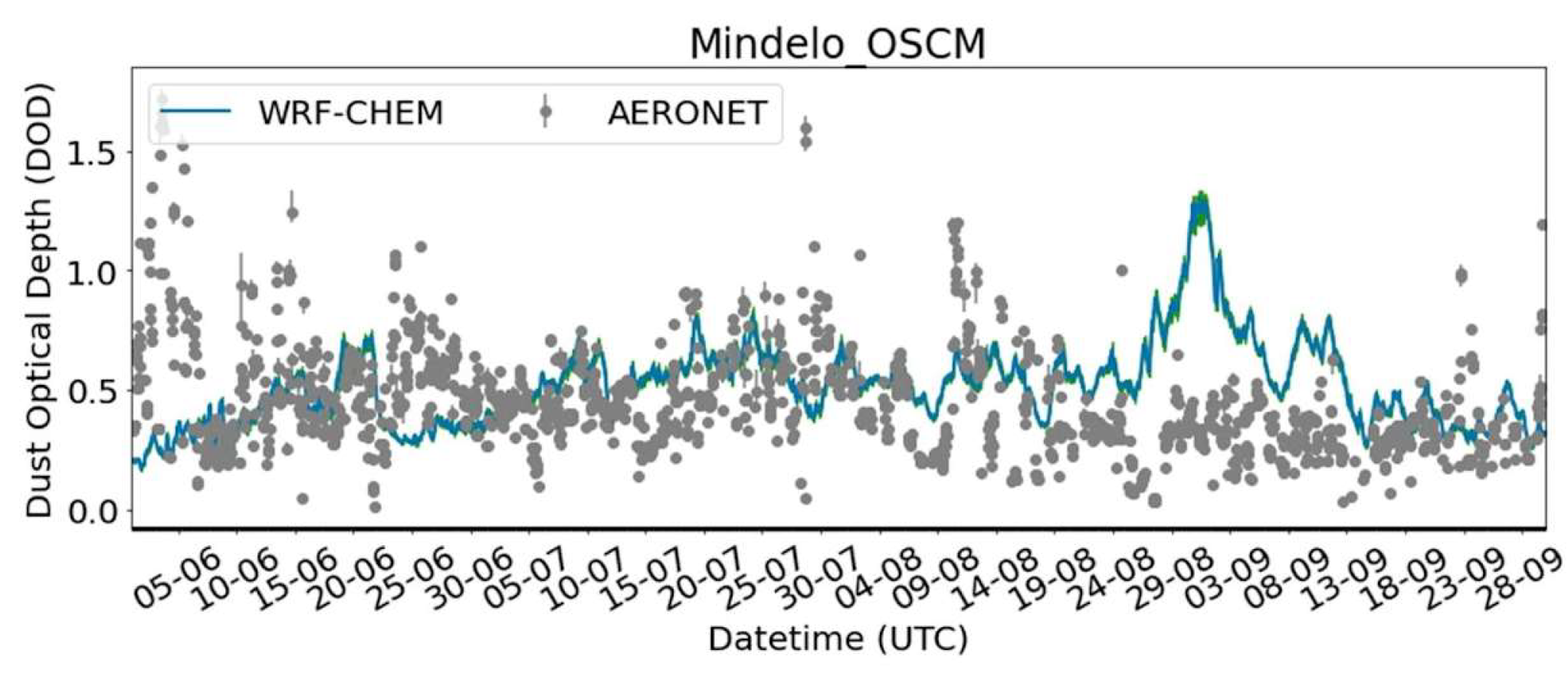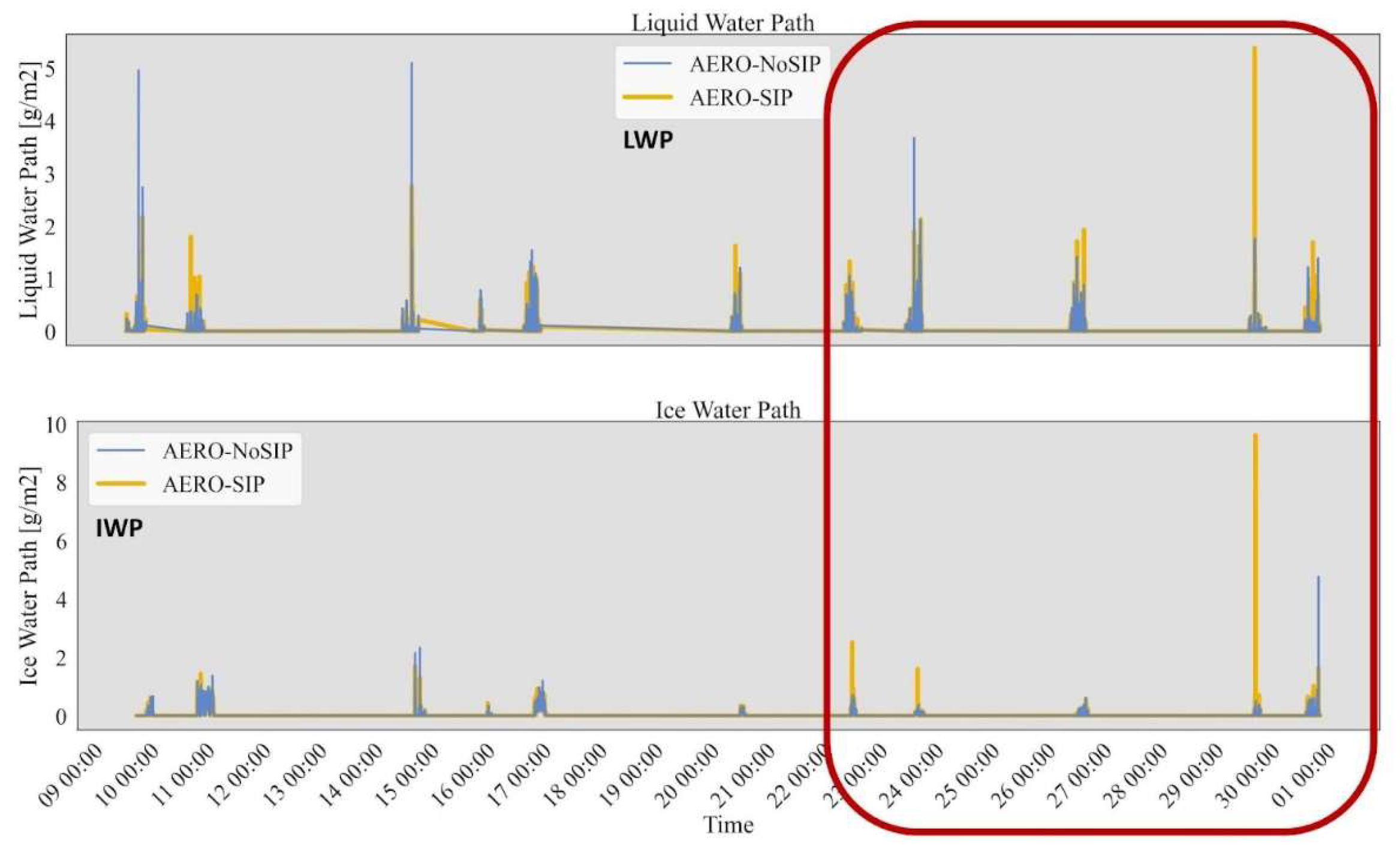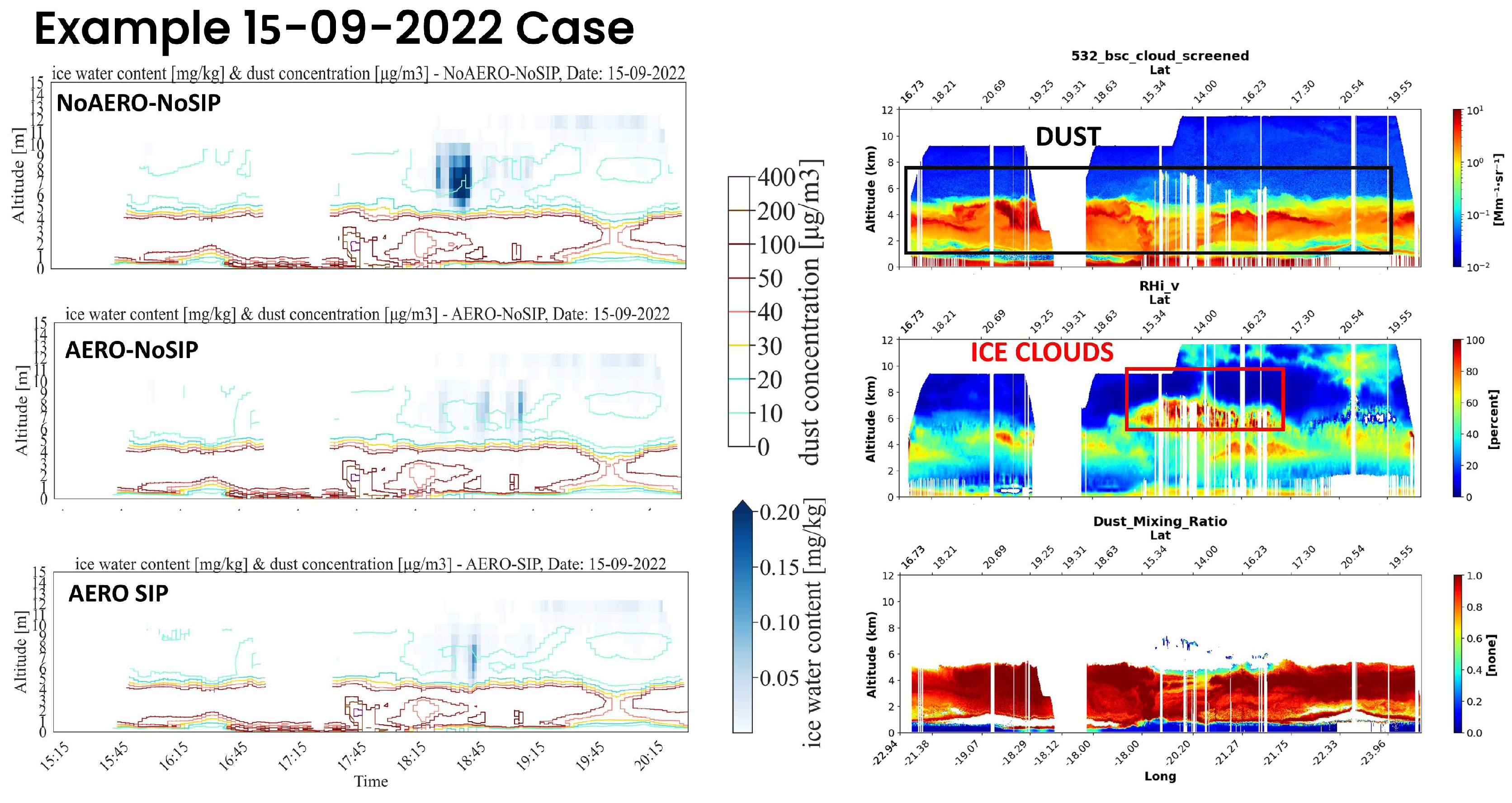Reconstructing Saharan Dust–Cloud Scenes with WRF-L: Initial Evaluation of Aerosol-Aware Ice Nucleation Schemes †
Abstract
1. Introduction
2. Methods
3. Results and Discussion
3.1. Simulated Aerosol Field
3.2. Simulated LWP and IWP
3.3. Simulated Cloud Scenes Against Aircraft Observations
4. Future Steps
- Perform detailed comparisons of model outputs with available ground-based and airborne radar measurements to evaluate the accuracy of cloud and ice structure simulations. This will help validate the sensitivity of the modeled IWP and LWP to aerosol–cloud interactions.
- Conduct large-eddy simulations (LESs) for selected days that exhibited significant differences between simulation setups in order to more accurately resolve cloud dynamics and microphysical processes influenced by mineral dust.
- Incorporate assimilated aerosol fields into the LES framework to better constrain the representation of dust layers and improve model initializations.
- Extend the simulations using available data from more recent campaigns.
Author Contributions
Funding
Institutional Review Board Statement
Informed Consent Statement
Data Availability Statement
Acknowledgments
Conflicts of Interest
Abbreviations
| LWP | Liquid water path |
| IWP | Ice water path |
| HALO | High-Altitude Lidar Observatory |
References
- Hoose, C.; Möhler, O. Heterogeneous Ice Nucleation on Atmospheric Aerosols: A Review of Results from Laboratory Experiments. Atmos. Chem. Phys. 2012, 12, 9817–9854. [Google Scholar] [CrossRef]
- Cziczo, D.J.; Froyd, K.D.; Hoose, C.; Jensen, E.J.; Diao, M.; Zondlo, M.A.; Smith, J.B.; Twohy, C.H.; Murphy, D.M. Clarifying the Dominant Sources and Mechanisms of Cirrus Cloud Formation. Science 2013, 340, 1320–1324. [Google Scholar] [CrossRef] [PubMed]
- Drakaki, E.; Amiridis, V.; Tsekeri, A.; Gkikas, A.; Proestakis, E.; Mallios, S.; Solomos, S.; Spyrou, C.; Marinou, E.; Ryder, C.L.; et al. Modeling Coarse and Giant Desert Dust Particles. Atmos. Chem. Phys. 2022, 22, 12727–12748. [Google Scholar] [CrossRef]
- Marinou, E.; Amiridis, V.; Paschou, P.; Tsikoudi, I.; Tsekeri, A.; Daskalopoulou, V.; Baars, H.; Floutsi, A.; Kouklaki, D.; Pirloaga, R.; et al. ASKOS Campaign 2021/2022: Overview of Measurements and Applications; display, 2023. In Proceedings of the EGU General Assembly 2023, Vienna, Austria, 23–28 April 2023. [Google Scholar]
- Nowottnick, E.P.; Rowe, A.K.; Nehrir, A.R.; Zawislak, J.A.; Piña, A.J.; McCarty, W.; Barton-Grimley, R.A.; Bedka, K.M.; Bennett, J.R.; Brammer, A.; et al. Dust, Convection, Winds, and Waves: The 2022 NASA CPEX-CV Campaign. Bull. Am. Meteorol. Soc. 2024, 105, E2097–E2125. [Google Scholar] [CrossRef]
- DeMott, P.J.; Prenni, A.J.; McMeeking, G.R.; Sullivan, R.C.; Petters, M.D.; Tobo, Y.; Niemand, M.; Möhler, O.; Snider, J.R.; Wang, Z.; et al. Integrating Laboratory and Field Data to Quantify the Immersion Freezing Ice Nucleation Activity of Mineral Dust Particles. Atmos. Chem. Phys. 2015, 15, 393–409. [Google Scholar] [CrossRef]
- Morrison, H.; Thompson, G.; Tatarskii, V. Impact of Cloud Microphysics on the Development of Trailing Stratiform Precipitation in a Simulated Squall Line: Comparison of One- and Two-Moment Schemes. Mon. Weather. Rev. 2009, 137, 991–1007. [Google Scholar] [CrossRef]
- Morrison, H.; Curry, J.A.; Khvorostyanov, V.I. A New Double-Moment Microphysics Parameterization for Application in Cloud and Climate Models. Part I: Description. J. Atmos. Sci. 2005, 62, 1665–1677. [Google Scholar] [CrossRef]
- Hallett, J.; Mossop, S.C. Production of Secondary Ice Particles during the Riming Process. Nature 1974, 249, 26–28. [Google Scholar] [CrossRef]
- Chen, F.; Dudhia, J. Coupling an Advanced Land Surface–Hydrology Model with the Penn State–NCAR MM5 Modeling System. Part I: Model Implementation and Sensitivity. Mon. Wea. Rev. 2001, 129, 569–585. [Google Scholar] [CrossRef]
- Jiménez, P.A.; Dudhia, J. Improving the Representation of Resolved and Unresolved Topographic Effects on Surface Wind in the WRF Model. JAMC 2012, 51, 300–316. [Google Scholar] [CrossRef]
- Iacono, M.J.; Delamere, J.S.; Mlawer, E.J.; Shephard, M.W.; Clough, S.A.; Collins, W.D. Radiative Forcing by Long-lived Greenhouse Gases: Calculations with the AER Radiative Transfer Models. J. Geophys. Res. 2008, 113, 2008JD009944. [Google Scholar] [CrossRef]
- Grell, G.A.; Dévényi, D. A Generalized Approach to Parameterizing Convection Combining Ensemble and Data Assimilation Techniques. Geophys. Res. Lett. 2002, 29, 38-1–38-4. [Google Scholar] [CrossRef]
- Nakanishi, M.; Niino, H. An Improved Mellor–Yamada Level-3 Model: Its Numerical Stability and Application to a Regional Prediction of Advection Fog. Bound.-Layer Meteorol. 2006, 119, 397–407. [Google Scholar] [CrossRef]
- Ginoux, P.; Chin, M.; Tegen, I.; Prospero, J.M.; Holben, B.; Dubovik, O.; Lin, S.-J. Sources and Distributions of Dust Aerosols Simulated with the GOCART Model. J. Geophys. Res. 2001, 106, 20255–20273. [Google Scholar] [CrossRef]
- LeGrand, S.L.; Polashenski, C.; Letcher, T.W.; Creighton, G.A.; Peckham, S.E.; Cetola, J.D. The AFWA Dust Emission Scheme for the GOCART Aerosol Model in WRF-Chem v3.8.1. Geosci. Model Dev. 2019, 12, 131–166. [Google Scholar] [CrossRef]
- Carroll, B.J.; Nehrir, A.R.; Kooi, S.A.; Collins, J.E.; Barton-Grimley, R.A.; Notari, A.; Harper, D.B.; Lee, J. Differential Absorption Lidar Measurements of Water Vapor by the High Altitude Lidar Observatory (HALO): Retrieval Framework and First Results. Atmos. Meas. Tech. 2022, 15, 605–626. [Google Scholar] [CrossRef]
- DeMott, P.J.; Prenni, A.J.; Liu, X.; Kreidenweis, S.M.; Petters, M.D.; Twohy, C.H.; Richardson, M.S.; Eidhammer, T.; Rogers, D.C. Predicting Global Atmospheric Ice Nuclei Distributions and Their Impacts on Climate. Proc. Natl. Acad. Sci. USA 2010, 107, 11217–11222. [Google Scholar] [CrossRef] [PubMed]
- Hunter, J.D. Matplotlib: A 2D Graphics Environment. Comput. Sci. Eng. 2007, 9, 90–95. [Google Scholar] [CrossRef]
- Hoyer, S.; Hamman, J. Xarray: N-D Labeled Arrays and Datasets in Python. JORS 2017, 5, 10. [Google Scholar] [CrossRef]
- Met Office. Cartopy: A Cartographic Python Library with a Matplotlib Interface, Cartopy. 2010. Available online: https://scitools.org.uk/cartopy (accessed on 16 September 2024).




| Parameterization | Scheme | Parameterization | Scheme |
|---|---|---|---|
| Surface Model | Noah [10] | sf_surface_physics | 2 |
| Surface Layer | MM5 [11] | sf_sfclay_physics | 2 |
| Radiation (SW and LW) | RRTMG [12] | ra_sw(lw)_physics | 4 |
| Microphysics | Morrison 2-moment [8] | mp_physics | 10 |
| Cumulus | Grell-3 [13] | cu_physics | 5 |
| Boundary Layer | MYNN 2.5 [14] | bl_pbl_physics | 5 |
| Chemistry | GOCART simple [15,16] | chem_opt | 300 |
| Dust Scheme | AFWA [16] | dust_opt | 3 |
| MODEL EXPERIMENTS | DUST_IN | SIP |
|---|---|---|
| NoAERO-NoSIP | No | No |
| AERO-NoSIP | yes | No |
| AERO-SIP | yes | Yes |
Disclaimer/Publisher’s Note: The statements, opinions and data contained in all publications are solely those of the individual author(s) and contributor(s) and not of MDPI and/or the editor(s). MDPI and/or the editor(s) disclaim responsibility for any injury to people or property resulting from any ideas, methods, instructions or products referred to in the content. |
© 2025 by the authors. Licensee MDPI, Basel, Switzerland. This article is an open access article distributed under the terms and conditions of the Creative Commons Attribution (CC BY) license (https://creativecommons.org/licenses/by/4.0/).
Share and Cite
Drakaki, E.; Marinou, E.; Nehrir, A.R.; Katsafados, P.; Amiridis, V. Reconstructing Saharan Dust–Cloud Scenes with WRF-L: Initial Evaluation of Aerosol-Aware Ice Nucleation Schemes. Environ. Earth Sci. Proc. 2025, 35, 21. https://doi.org/10.3390/eesp2025035021
Drakaki E, Marinou E, Nehrir AR, Katsafados P, Amiridis V. Reconstructing Saharan Dust–Cloud Scenes with WRF-L: Initial Evaluation of Aerosol-Aware Ice Nucleation Schemes. Environmental and Earth Sciences Proceedings. 2025; 35(1):21. https://doi.org/10.3390/eesp2025035021
Chicago/Turabian StyleDrakaki, Eleni, Eleni Marinou, Amin R. Nehrir, Petros Katsafados, and Vassilis Amiridis. 2025. "Reconstructing Saharan Dust–Cloud Scenes with WRF-L: Initial Evaluation of Aerosol-Aware Ice Nucleation Schemes" Environmental and Earth Sciences Proceedings 35, no. 1: 21. https://doi.org/10.3390/eesp2025035021
APA StyleDrakaki, E., Marinou, E., Nehrir, A. R., Katsafados, P., & Amiridis, V. (2025). Reconstructing Saharan Dust–Cloud Scenes with WRF-L: Initial Evaluation of Aerosol-Aware Ice Nucleation Schemes. Environmental and Earth Sciences Proceedings, 35(1), 21. https://doi.org/10.3390/eesp2025035021







